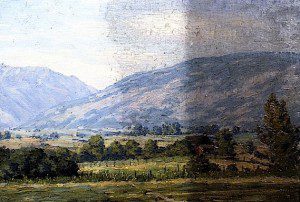
Tagged 5th St. Mural in LA
There are new efforts being put forth by companies, city and state government, artists and art related associations to deal with the vandals and disgrace of tagging and graffiti. Why is there so much attention being given to this important involvement of preserving and the conservation of murals at this time?
Because of the realization that almost all of the most important artworks of this movement nationwide dating prior to the 1970s are disappearing. From the 1960s, this visual language has evolved. How do we choose to conserve and preserve these images located in public? It mostly depends on if the wall is public or private. Was the mural commissioned or just another illegal expression. It is their accessibility that exposes them to weather, graffiti, tagging and the surfaces on which murals are painted can damage the artwork over time. Hundreds of murals from the 1970s and 1980s are in severe disrepair. Without serious conservation and preservation they will parish.
The freeway murals in downtown LA are the subject of the constant battle against graffiti and tagging vandals. Caltrans (the highway maintenance authority in the State of California) is required by law to keep graffiti under control and off walls. Therefore, the distressing result is that the majority of the 1984 Olympic freeway murals, for instance, are painted over with gray paint by Caltrans to cover graffiti and tagging.
There have been some new developments and new techniques in the processes of contemporary mural restoration and art conservation in the removal of graffiti and mural protection, with most of the art conservation/restoration work is done under the guidance of the original artist. This collaboration makes the final result much more in line with the artist’s intent and leaves the mural more “original.” These murals and other surfaces in every community are tagged or covered with graffiti.
Do you think a mural artists or street artists accept or like the tagger’s way of expression?
The task of maintenance seems to some unimaginative city officials to surpass the funding in most cities but this is actually a battle of urban pride and priorities, not so much budgets. There are dozens of way to incite public pride, such “Adopt a Mural”… even ways that would not cost the city direct financial costs.
This battle with the spray can delinquent is usually a matter of dealing with 13 and 14 year olds that don’t have attentive parents and don’t have parents with resources to clean up the mess even though there are laws that if the vandals are caught, the parents should pay the bill. A community service program may sever as a remedy with an observed tag removal on a plain wall. It can be a gang thing but I’ve been in Gangland where murals are respected. Let’s call the majority of taggers simply bored kids looking for a thrill. Most or all of them will “be over it” by the time they are 16 and most taggers are truly sorry for their tagging days when they hit their 20’s.
If we show the youth how to partake in a movement that is important, like being involved with real street artists, to have pride in being involved in projects that deserve to be recognized then the visual language becomes theirs, and the courage to get involved in the effort to protecting the murals will continue.

Street art or vandalism?
http://www.youtube.com/watch?v=SH-aLDBTuhk
http://www.fineartconservationlab.com/projects/murals/kent-twitchell-partners-with-scott-haskins-to-finish-art-conservation-of-mural-at-biola-university/
If you have any question on mural restoration, please contact Scott Haskins at
Fine Art Conservation Laboratories: (805) 5643438 Best_artdoc@yahoo.com
Art appraisal questions? Call Richard at 805 895 5121
What can you do at home to protect and save your collectibles from natural disasters” Go to
See an important tip for collectors at www.tipsforartcollectors.org/blacklight-package

Vandals deface neighborhood mural with graffiti









